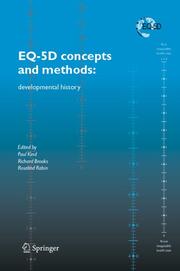-
Zusatztext
-
Science today makes progress through the imaginative harvesting of knowledge g- erated by the many, rather than as the result of the isolated endeavours of the lone researcher. Innovations in the physical sciences from the development of nuclear te- nologies to the laser, have involved research teams working collectively. Collabo- tion is the rule rather than the exception. In the social sciences this model is all but reversed. Here it is not uncommon to encounter the solitary enthusiast, relishing an independence of spirit and pursuing their own private research agenda. All the more surprising then that a group of researchers from several different disciplines, should have come together in the late 1980s with nothing more substantial on the agenda than that they share their thoughts on the topic of measuring the value of health, or more specifically, on the way that the value of health might vary across different countries. Few scientific enterprises can have begun as cautiously or uncertainly. Few can have developed a cohesion and dynamism that lasted decades and continues to drive ahead after long years of scientific endeavour. Such is the good fortune that befell those of us who came together to form what was later to be known as the Euro- Qol Group. The Group's creation is principally due to the shared professional asso- ation of its members with one man, an economist by training and a visionary academic by inclination and temperament - Alan Williams.
-
-
Kurztext
-
InhaltsangabeList of contributors; Foreword; Acknowledgements; List of tables; List of figures; 1. The EuroQol instrument, Alan Williams; 2. The descriptive system of the EuroQol Instrument, Claire Gudex; 3. The number of levels in the descriptive system, Heleen van Agt and Gouke Bonsel; 4. First steps to assessing semantic equivalence of the EuroQol, Instrument: Results of a questionnaire survey to members of the EuroQol Group, Julia Fox-Rushby; 5. Comparing general health-relates quality of life (HRQoL) questionnaires; EuroQol, Sickness Impact Profile and Rosser Index, Stefan Björk and Ulf Persson; 6. Influence of self-rated health and related variables on EuroQolvaluation of health states in a Spanish population, Xavier Badia, Esteve Fernandez and Andreu Segura; 7. Observations on one hundred students filling in the EuroQol questionnaire, Jan Busschbach, Dick Hessing and Frank de Charro; 8. Eliciting EuroQol descriptive data and utility scale values from inpatients, Caroline Selai and Rachel Rosser; 9. Testretest reliability of health state valuations collected with the EuroQol questionnaire, Heleen van Agt, MarieLouise EssinkBot, Paul Krabbe and Gouke Bonsel; 10. Hypothetical valuations of health states versus patients' self-ratings, Erik Nord, Xavier Badia, Montserrat Rue and Harri Sintonen; 11. Inconsistency and health state valuations, Paul Dolan and Paul Kind; 12. Issues in the harmonisation of valuation and modeling, Paul Krabbe, Frank de Charro and Marie-Louise Essink-Bot; 13. Estimating a parametric relation between health description and health valuation using the EuroQol Instrument, Ben van Hout and Joseph McDonnell; 14. Some considerations concerning negative values for EQ 5D health states, Frank de Charro, Jan Busschbach, Marie-Louise Essink-Bot, Ben van Hout and PaulKrabbe; 15. Health states considered worse than 'being dead', Stefan Björk and Rikard Althin; 16. The effect of duration on the values given to the EuroQol states, Arto Ohinmaa and Harri Sintonen; 17. Applying paired comparisons models to EQ-5D valuations - deriving TTO utilities from ordinal preference data, Paul Kind; 18. The use and usefulness of the EuroQol EQ-5D: preliminary results from an international survey, Rosalind Rabin, Paul Kind and Frank de Charro; 19. Not a quick fix, Martin Buxton; Appendices.
-
-
Autorenportrait
- InhaltsangabeList of contributors; Foreword; Acknowledgements; List of tables; List of figures; 1. The EuroQol instrument, Alan Williams; 2. The descriptive system of the EuroQol Instrument, Claire Gudex; 3. The number of levels in the descriptive system, Heleen van Agt and Gouke Bonsel; 4. First steps to assessing semantic equivalence of the EuroQol, Instrument: Results of a questionnaire survey to members of the EuroQol Group, Julia Fox-Rushby; 5. Comparing general health-relates quality of life (HRQoL) questionnaires; EuroQol, Sickness Impact Profile and Rosser Index, Stefan Björk and Ulf Persson; 6. Influence of self-rated health and related variables on EuroQolvaluation of health states in a Spanish population, Xavier Badia, Esteve Fernandez and Andreu Segura; 7. Observations on one hundred students filling in the EuroQol questionnaire, Jan Busschbach, Dick Hessing and Frank de Charro; 8. Eliciting EuroQol descriptive data and utility scale values from inpatients, Caroline Selai and Rachel Rosser; 9. Testretest reliability of health state valuations collected with the EuroQol questionnaire, Heleen van Agt, MarieLouise EssinkBot, Paul Krabbe and Gouke Bonsel; 10. Hypothetical valuations of health states versus patients' self-ratings, Erik Nord, Xavier Badia, Montserrat Rue and Harri Sintonen; 11. Inconsistency and health state valuations, Paul Dolan and Paul Kind; 12. Issues in the harmonisation of valuation and modeling, Paul Krabbe, Frank de Charro and Marie-Louise Essink-Bot; 13. Estimating a parametric relation between health description and health valuation using the EuroQol Instrument, Ben van Hout and Joseph McDonnell; 14. Some considerations concerning negative values for EQ 5D health states, Frank de Charro, Jan Busschbach, Marie-Louise Essink-Bot, Ben van Hout and PaulKrabbe; 15. Health states considered worse than 'being dead', Stefan Björk and Rikard Althin; 16. The effect of duration on the values given to the EuroQol states, Arto Ohinmaa and Harri Sintonen; 17. Applying paired comparisons models to EQ-5D valuations - deriving TTO utilities from ordinal preference data, Paul Kind; 18. The use and usefulness of the EuroQol EQ-5D: preliminary results from an international survey, Rosalind Rabin, Paul Kind and Frank de Charro; 19. Not a quick fix, Martin Buxton; Appendices.
Detailansicht
EQ-5D concepts and methods
A developmental history
ISBN/EAN: 9781402037115
Umbreit-Nr.: 1485943
Sprache:
Englisch
Umfang: xxii, 240 S.
Format in cm:
Einband:
gebundenes Buch
Erschienen am 24.10.2005
Auflage: 1/2005


